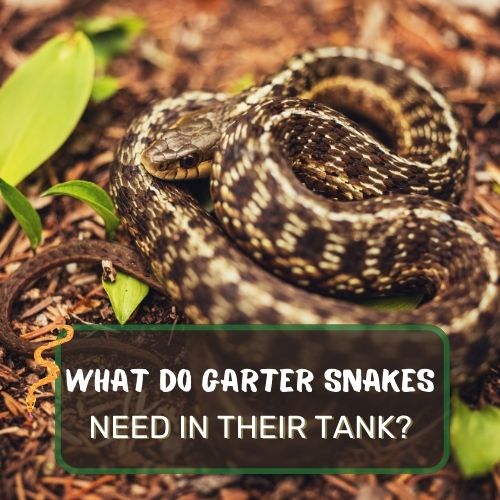As cat parents, we’ve got a million worries— from which toy they’d prefer, to more serious concerns like potential dangers lurking in the yard. Among those concerns? The possibility of a garter snake giving our furry friend a little nip.
But how worried should we be?
Yes, a garter snake bite can hurt a cat. While garter snakes have mild venom that’s typically harmless to cats, the primary concern is bacterial infections from the bite. Immediate reactions might include swelling or redness, and there’s a potential for longer-term infections or allergic reactions.
In this piece, we delve deep into the mystery of the garter snake bite. Is their venom a concern? How about bacterial infections? And if your cat does get bitten, what’s the game plan?
We’ve analyzed everything from immediate reactions to prevention methods. So, let’s embark on this feline-safety journey together!

Table of Contents
Are Garter Snake Bites Venomous?
For many, the sight of any snake can induce a mild heart attack, but for cat owners, a specific concern arises: “What if Fluffy gets too curious and ends up at the wrong end of a snake bite?” Let’s unpack that, shall we?
Misconceptions about garter snake venom
First off, let’s get something straight. Hollywood and those crazy viral videos might’ve given all snakes a rep of being dangerous, venom-spewing creatures. But with garter snakes? Not quite the case. Many people believe that garter snakes are entirely non-venomous.
And while they’re more on the harmless end of the snake spectrum, it’s not entirely accurate to say they lack venom.
The mild venom of garter snakes
Garter snakes produce a venom. Surprise! But before you go banishing them from your backyard, consider this: their venom isn’t really potent, at least not to us larger beings.
It’s evolved primarily to help them subdue and digest their tiny prey—think worms, amphibians, and the occasional small fish. For humans, a bite might cause some mild irritation, but that’s generally the extent of it.
Now, if you’re asking, “But what about cats?”, that’s a bit of a different story. Cats, while larger than worms and frogs, are still much smaller than humans. If your feline friend got bitten, they might experience more discomfort than we would.
However, remember that due to the garter snake’s small, rear-facing teeth (more on that in a bit), it’s quite challenging for them to deliver venom to something as large as a cat.
Its effects on larger animals and humans
For larger animals, including us talkative two-legged beings, the venom of a garter snake is pretty inconsequential. At most, you might feel a burning sensation, see some swelling or redness, but that’s about it.
No dramatic collapsing, no calls to poison control. So, if you ever get bitten while trying to save a worm from becoming lunch, don’t panic.
And for the curious cat in your life? Well, it’s a bit more of a grey area. Cats have a different physiology and might react differently to garter snake venom.
However, most anecdotal evidence suggests that while a bite might be painful and cause some localized swelling, it’s not usually life-threatening.
Structure of their teeth: tiny and rear-facing
Garter snakes, unlike some of their more menacing cousins, have tiny teeth that are rear-facing. Think of them as nature’s little fish hooks. These teeth are designed for gripping onto their wriggly meals, not delivering venom to large creatures.
For a garter snake to envenomate a creature (like your cat), it would need to bite and then almost “chew” to work the venom in, a scenario that’s quite unlikely given a cat’s reflexes.
So, while it’s technically possible for a garter snake to deliver venom to a cat, it’s not super probable.

The Real Danger: Bacterial Infections
While we’ve established that the venom isn’t much of a concern for your whiskered pal, there’s another aspect of a snake bite that could be more problematic: bacterial infections.
Why the bite wound is more concerning than venom
Any break in the skin, be it from a playful scratch from another cat, a prick from a thorn, or yes, a bite from a snake, can be a gateway for bacteria.
And guess what?
The mouth of a garter snake, like many animals, isn’t exactly a sterile environment.
Common bacteria present in snake mouths
Garter snakes often feast on a diet of frogs, worms, and occasionally fish. With such a menu, it’s no wonder their mouths can harbor various bacteria, including Salmonella.
These bacteria, if introduced into a wound, can cause infections. It’s kind of like when we humans are warned about human bites being potentially more infectious than animal bites – mouths, regardless of the species, are teeming with bacteria.
Signs of infection in cats
If your cat gets bitten, monitor the site for signs of infection. This could include increased redness, warmth at the bite site, pus, or a foul odor. Your feline friend might also seem lethargic or lose their appetite. If you notice these signs, it’s vet time, pronto.

Symptoms of a Garter Snake Bite in Cats
Alright, so let’s say your cat, being the curious critter they are, decides to poke their nose where it doesn’t belong and ends up with a souvenir from a garter snake. What should you look out for?
Immediate reactions: swelling, redness, or discomfort
Firstly, the site of the bite. Just like if you or I got a nip, there’ll likely be some localized swelling and redness. Your cat might also keep licking or pawing at the area, showing they’re feeling a bit of discomfort.
Long-term symptoms: potential infections or allergic reactions
Now, while most reactions will be immediate, it’s essential to keep a close eye on the bite area for a few days. As we discussed earlier, bacterial infections are a potential risk.
In addition to this, though rare, some cats might have an allergic reaction to the bite, which could manifest as hives, difficulty breathing, or excessive swelling.
Again, if anything seems off or if you’re in doubt, always better to err on the side of caution and pay a visit to your trusted vet.

What to Do If Your Cat Gets Bitten
So, you’ve just witnessed the unthinkable. Your cat, in a bold display of feline bravado, decided to investigate a garter snake a tad too closely and, well, things went south.
Now you’re panicking, replaying that split-second in your mind, wondering what the heck to do next.
Immediate first-aid steps
- Safety First: Before anything else, ensure you’re not at risk of getting bitten too. Move the cat away from the snake and into a secure location.
- Inspect the Bite: Gently examine the bite site. If there’s any debris, clean it off gently with warm water. Avoid using any strong antiseptics or ointments just yet – let’s not aggravate the area more.
- Avoid Squeezing: It might be tempting to squeeze the bite area to “get the venom out.” Remember, the venom isn’t the primary concern here, and squeezing could exacerbate the injury.
When to rush to the vet
Always treat a snake bite on your cat as a potential emergency. Even if the garter snake’s venom isn’t a significant threat, the risk of bacterial infection is real.
- Immediate Severe Reactions: If your cat shows signs of distress, labored breathing, or a severe allergic reaction, rush to the vet immediately.
- Signs of Infection: As mentioned earlier, redness, swelling, pus, or an unusually warm bite site are signals to seek professional help.
- Behavioral Changes: If your usually energetic kitty suddenly becomes lethargic, refuses food, or acts ‘off,’ it’s vet time.
Tips on calming your cat post-bite
- Quiet Space: Cats, when stressed or hurt, prefer solitude. Place them in a quiet, dimly lit room away from household hustle and bustle.
- Comfort Items: Familiar toys, their favorite blanket, or even an old shirt of yours can provide comfort.
- Gentle Talk: Speak to them in soft, soothing tones. Your voice can be an anchor of comfort in their time of stress.
- Avoid Force: While you might want to inspect the bite or clean it continually, avoid handling your cat too much post-bite. They’re likely shaken up, and too much handling can add to their stress.

Preventing Cat-Snake Encounters
We’d much prefer those whiskered adventurers and slinky serpents to keep their respective distances. Let’s chat about how to make that happen.
Making your yard less attractive to snakes
Snakes, like that one relative who overstays their welcome, are attracted to certain amenities. If you have a yard or garden:
- Manage the buffet: Clear away food sources like insects, amphibians, and rodents. Regular mowing, avoiding over-watering, and keeping trash secured can help.
- Declutter: Snakes love hiding spots! Remove piles of wood, leaves, or debris. Keep grass short and shrubbery well-trimmed.
Supervising outdoor cat activities
Your cat’s outdoor time doesn’t have to end, but maybe tweak how it’s done.
- Leashed Walks: Consider taking your cat out on a leash (yes, it’s a thing, and it’s as adorable as it sounds). This way, you control where they go.
- Safe zones: Think about creating a cat-friendly enclosure or “catio” – a space where your cat can enjoy the outdoors without the risk of encountering unwanted guests.
Teaching cats to avoid snakes (if possible)
Alright, the jury’s still out on this one. While cats are smart cookies, it’s challenging to teach them to avoid snakes consistently.
- Natural Instinct: Some cats, especially if they’ve had an unpleasant encounter, might naturally avoid snakes in the future.
- Positive Reinforcement: While it’s tricky, if you catch your cat approaching a snake, a firm “No!” followed by rewarding them when they stay away might work over time.

Summary
You’ve journeyed through the ins and outs of garter snake bites and their potential effects on cats. We’ve dispelled myths about their venom and underscored the importance of watching for bacterial infections.
Remember, while garter snake bites may not be deadly, they’re not entirely harmless either.
Keep an eye on your feline friend’s outdoor escapades and make your space less snake-friendly. With knowledge and vigilance, you’re well-equipped to ensure your cat’s safety. Stay informed and keep those purring pals protected!
FAQ
Alright, let’s dive into some rapid-fire Q&A, because we all have those burning questions, right?
How do you tell if my cat has been bitten?
Look for puncture wounds, typically in pairs. The site might be red, swollen, and your cat might excessively lick or paw at it.
Can cats defend themselves against snakes?
Cats have sharp reflexes and might attempt to bat at or pounce on snakes. However, this doesn’t mean they’re immune to bites. It’s a risky game of cat-and-mouse (or in this case, cat-and-snake)!
What should I do if my cat has been bitten?
Clean the wound gently, keep your cat calm, and head to the vet ASAP, especially if you observe signs of infection or severe allergic reactions.
Got more questions? Always best to consult with professionals and trust your gut. Because when it comes to our furry family members, being overcautious is never a bad thing!




0 Comments